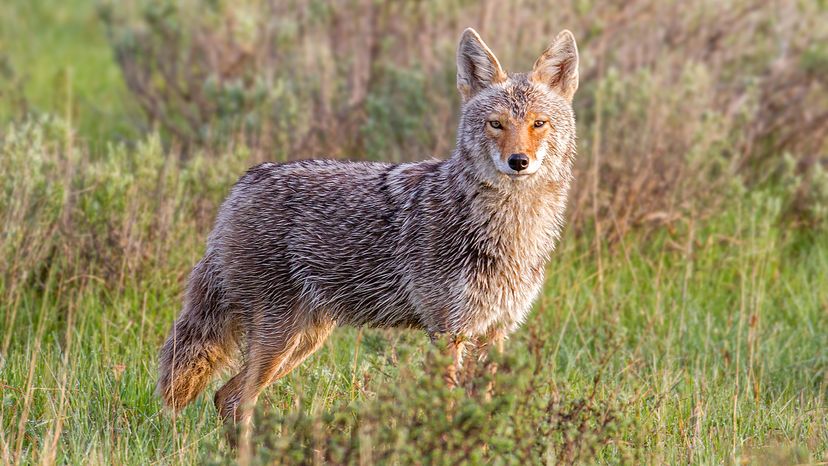Here are some of the major physical differences between wolves and coyotes.
1. Coyotes Are Much Smaller Than Wolves.
When comparing their sizes, you’ll find adult wolves outrank coyotes in every single way. A coyote stands at 24 inches (61 cm) at the shoulder and measures 3.3 to 4.3 feet (1 to 1.3 meters) long, whereas a wolf may be as tall as 30 inches (76 cm) at the shoulder and closer to 6.6 feet (2 meters) long.
A wolf carries more heft, too. The Canadian timber wolf can tip the scales at 175 pounds (79.4 kg), making it one of the world's largest wolves. Adult coyotes tend to be leaner, maxing out at around 50 pounds (22.7 kg).
Despite this difference in weight, the animals’ top running speeds are closer than you might guess: 40 miles (64 km) per hour for a coyote and 37 miles (60 km) per hour for a wolf.
2. Wolves Have Thicker Coats Compared to Coyotes.
In general, coyotes’ coats are thinner, helping them to regulate their body temperature in arid habitats. Wolves, on the other hand, have thicker coats, especially in colder climates, where their dense fur insulates them against the harsh weather conditions.
In terms of color, the animals’ coats can appear similar. Coyote coats are usually a mix of grays and browns but can also include some red or tan, while wolves’ coats may include shades of gray, brown, black, white or red. In both cases, the mix of colors helps the species blend into their environments.
3. Wolves’ Heads Are Bigger and Broader.
Coyote heads are relatively smaller in proportion to their bodies, although their ears are larger and more prominent relative to their own head size. They also have a more pointed and narrow snout, which aids in their ability to forage and catch small prey.
In contrast, wolf heads are larger and more pronounced in proportion to the size of their bodies, with broader snouts and powerful jaws that enable them to tackle larger prey. Compared to coyotes, wolves have shorter and less prominent ears; while still effective, their sense of hearing may not be as finely tuned.
4. Coyotes Yip, Whereas Wolves Howl.
When coyotes howl, their vocalizations sound higher-pitched or even squeaky compared to the deep, mournful-sounding howls of wolves. Coyotes are more famous for their yips, yelps and barks, which alert pack members to danger or help coordinate their group during a hunt.
By contrast, wolves are crooners, known for their haunting howls that echo through the wilderness. These sounds facilitate long-distance communication and reinforce social bonds within the wolf pack. Like other canines, wolves produce sharp barks, growls, and whines for intra-pack communication; however, their hallmark trait is synchronized, almost harmonic group howling.
5. Coyote Tracks Tend to Be More Oval, While Wolf Tracks Are More Rounded.
Coyote footprints are roughly 2.5 inches (6 centimeters) long by 2 inches (5 centimeters) wide and more compact than those of wolves. They have four relatively straight and elongated toes and distinct claw marks — signs of their adaptability for both digging and hunting.
Standard wolf tracks look similar but measure about 4 inches (10 centimeters) wide and 5 inches (12 centimeters) long, making coyote tracks appear positively pint-sized by comparison. The larger prints reflect the heavier size of the species, with toes that appear more splayed, creating a broader, more circular impression.
Claw marks are less noticeable on wolf tracks because they have more padding on their feet.
